Culture
How to Use a Bong
Published
1 year agoon
By
admin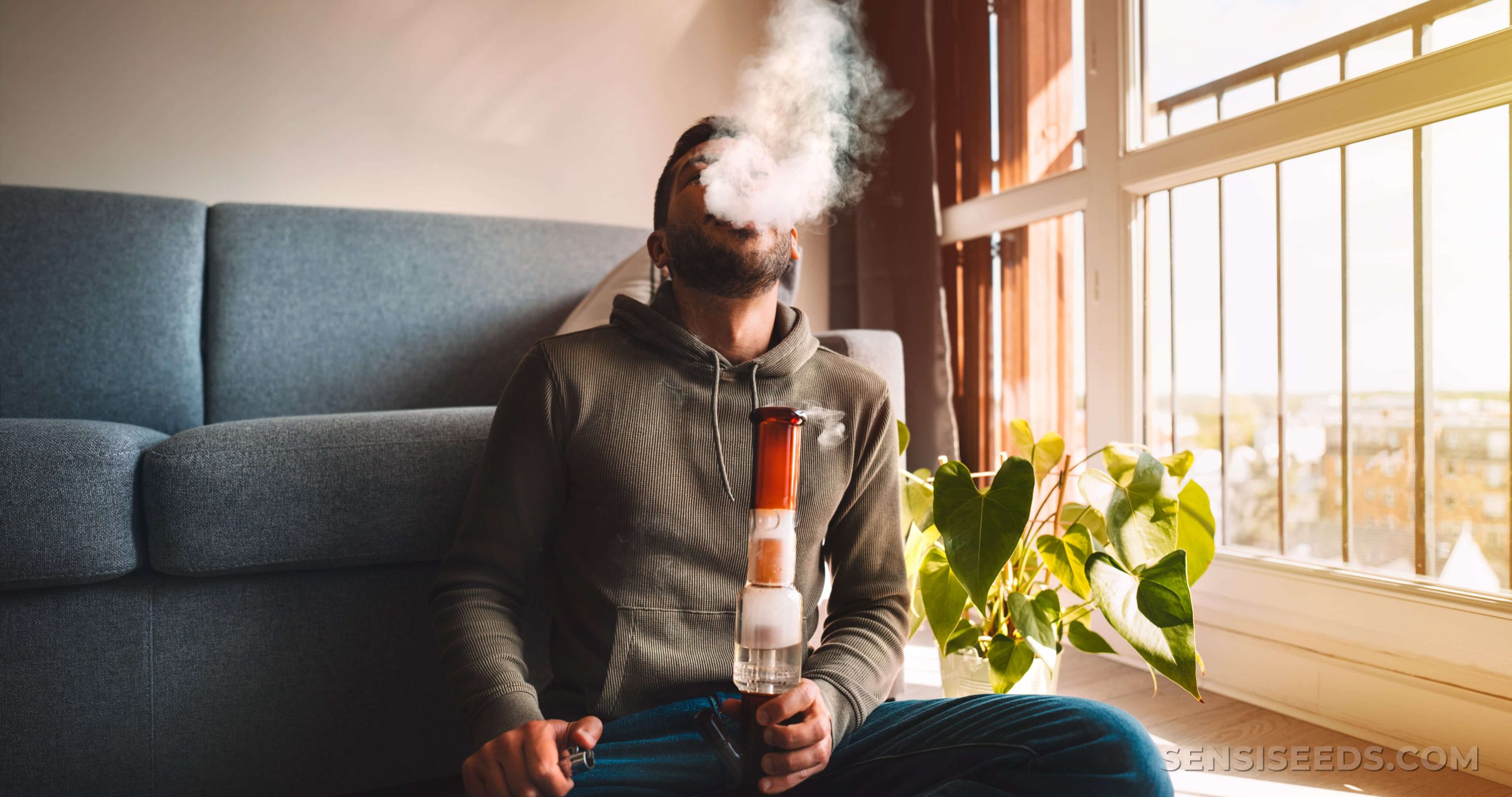
A bong is a waterpipe that has been used to smoke dry herbs, including tobacco and other dried plants for centuries. Having gained popularity within the cannabis community, we guide you through the basics of using a bong in our step-by-step guide and explain how they work and how to keep your bong clean!
The renaissance of the bong started in the 1960s in the United States by Bob Snodgrass, also known as the Godfather of Glass. He introduced hundreds of Grateful Dead fans to his mind-blowing glass-blowing techniques and created the glass-blowing subculture that can be seen across countless headshops today.
Now, it’s a common fact that almost every stoner has smoked a bong or owns one. Bongs have become popular in the cannabis subculture, and many will remember the iconic scene in Grandma’s Boy, where a glass bong was used as a flower vase. Nevertheless, many will ask, what are they made from, how do you use them, and why?
What is a bong?

A bong, often called a water pipe, is a smoking apparatus used to consume dried herbs and hash. The word bong is derived from baung, and the word’s first use in Western culture was in the McFarland Thai-English Dictionary, published in 1944. A bong was described as “a bamboo waterpipe for smoking kancha, tree, hashish, or the hemp plant.”
They are vertical, with a base for the water to sit in and a chamber for the smoke to collect in. Like a pipe, the bowl is where the cannabis is burned and connects to the base with a short tube. It pulls smoke through the water into the vertical chamber, ready to inhale.
The water in the bong provides a means of filtration, cooling the smoke before it is inhaled into the consumer’s lungs. They come in various shapes and sizes and can be made from five mediums, but more on that later!
How do bongs work?
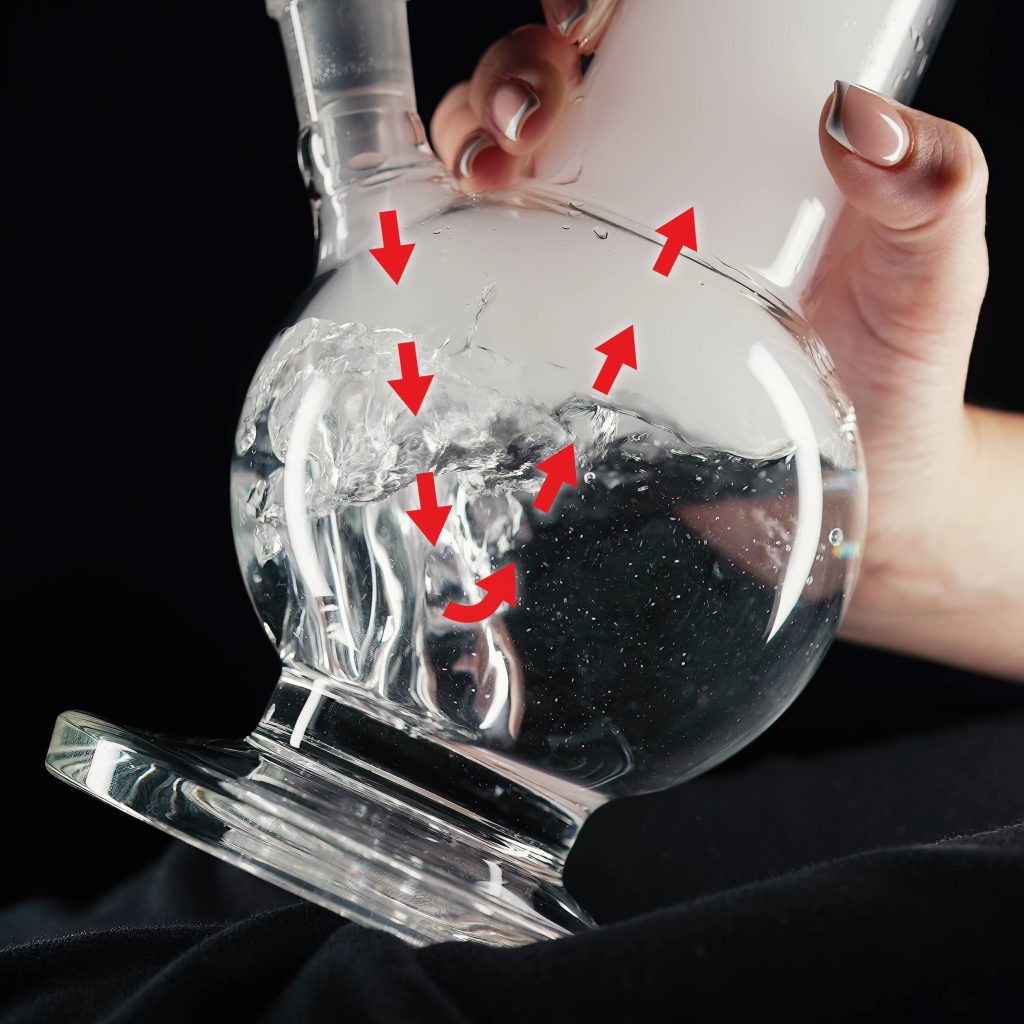
The bong works on fundamental physics. When igniting your dry flower, it will start to combust and release smoke, which will be drawn through the downstem into the chamber. Once you begin to inhale, a vacuum inside the bong is created.
The smoke percolates through the water, which acts as a diffuser to cool the smoke before it rises into the chamber. Because the outside pressure is greater than the pressure inside the chamber, the smoke will be left inside until the carb or bowl is removed. Once the airflow is opened, the smoke will rush into the lungs.
Why do people use bongs?
Compared to other methods of consuming cannabis, the bong is, by far, one of the easiest. For example, there is no need to roll, and you can easily manage dosing requirements. They are ideal for consuming a minimal amount of cannabis, giving you a large dosage while using minimal amounts of dried flowers.

During inhalation, joints can often be harsh on the throat. Consuming cannabis through a bong lowers the temperature of the smoke through water filtration, providing a smoother hit. When smoking a joint, cannabis emits a pungent aroma which accumulates in the air, which may cause unwanted attention. Bongs limit the amount of smoke and are an excellent alternative.
What materials can bongs be made of?
Bongs can be made from five primary materials, and each has its advantages and disadvantages, so let us take a look at each:
1. Glass

Glass bongs are the most popular within the cannabis community, giving you a clean and pure taste. They come in many different styles and shapes, some extraordinarily extravagant and attractive.
Seeing the smoke rise in the chamber is incredible and is an excellent indicator of the size of the bong hit. However, be warned that if you don’t clean your bong regularly, you will see a gradual build-up of resin, and glass is a highly fragile material.
Luckily, they’re straightforward to clean using isopropyl alcohol. Putting your bong in the dishwasher is not recommended, as high temperatures can lead to cracking and a build-up of unwanted resin in the cleaning department of your washer.
2. Bamboo

Bamboo bongs are traditional throughout Asia and have been used for centuries. Handcrafted from natural bamboo, they are basic but provide an effective consumption method. Bamboo is highly durable and perfect for those social occasions if you have an incredibly clumsy group of friends.
Most bamboo bongs will have beeswax lining to avoid the build-up of tar. In terms of cleanability, they require a more intricate cleaning process compared to other materials to help preserve the delicate lining.
3. Acrylic
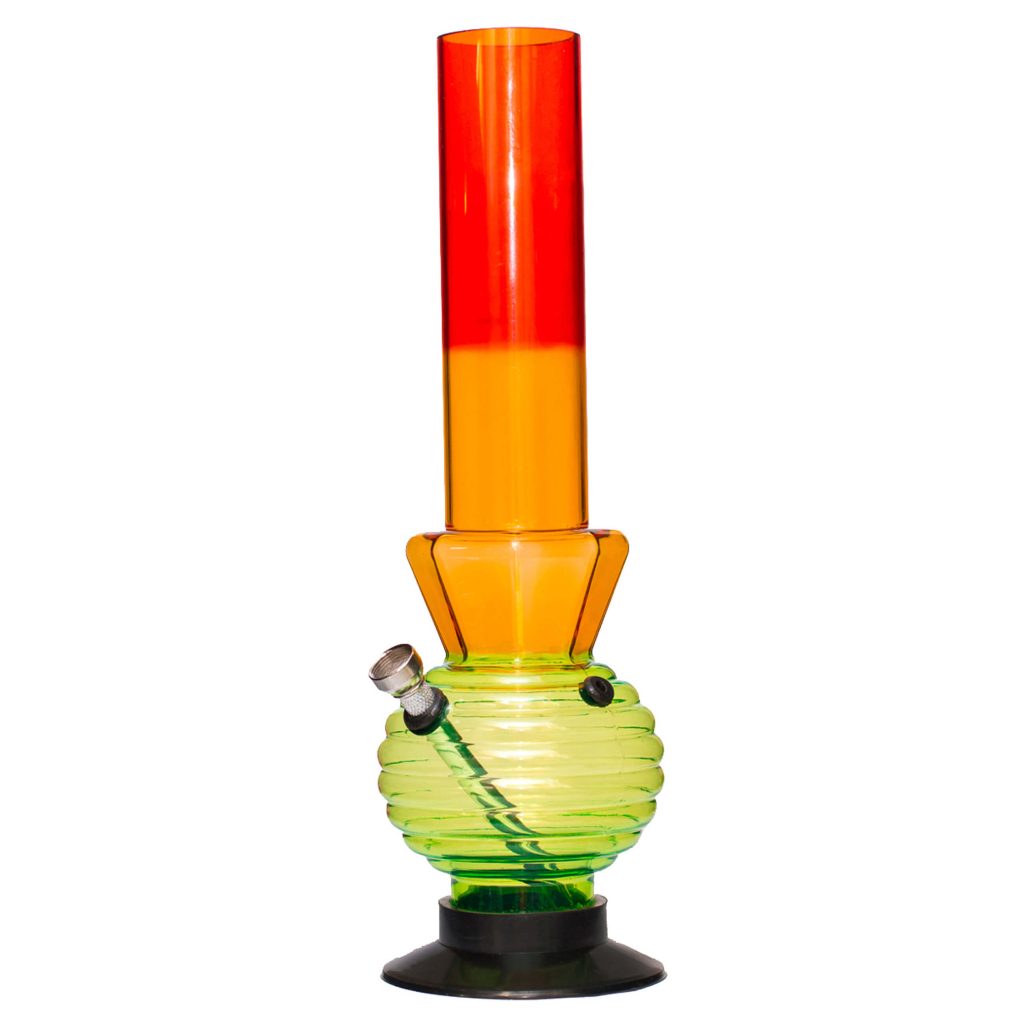
If you want a cost-effective option, acrylic bongs are the cheapest on the market, highly durable and long-lasting. They’re great for beginners looking for an entry-level bong.
Nevertheless, there are several drawbacks to acrylic bongs. They are rudimentary, and unlike glass or ceramic, they begin to taste harsh after the first few hits, hindering the smoking experience. Although they can be cleaned, removing the accumulation of resin is a very time-consuming process.
If you want a bong to display, steer away from acrylic bongs. But, if you’re looking for a sturdy, hardwearing bong for travelling and parties – this could be it.
4. Ceramic
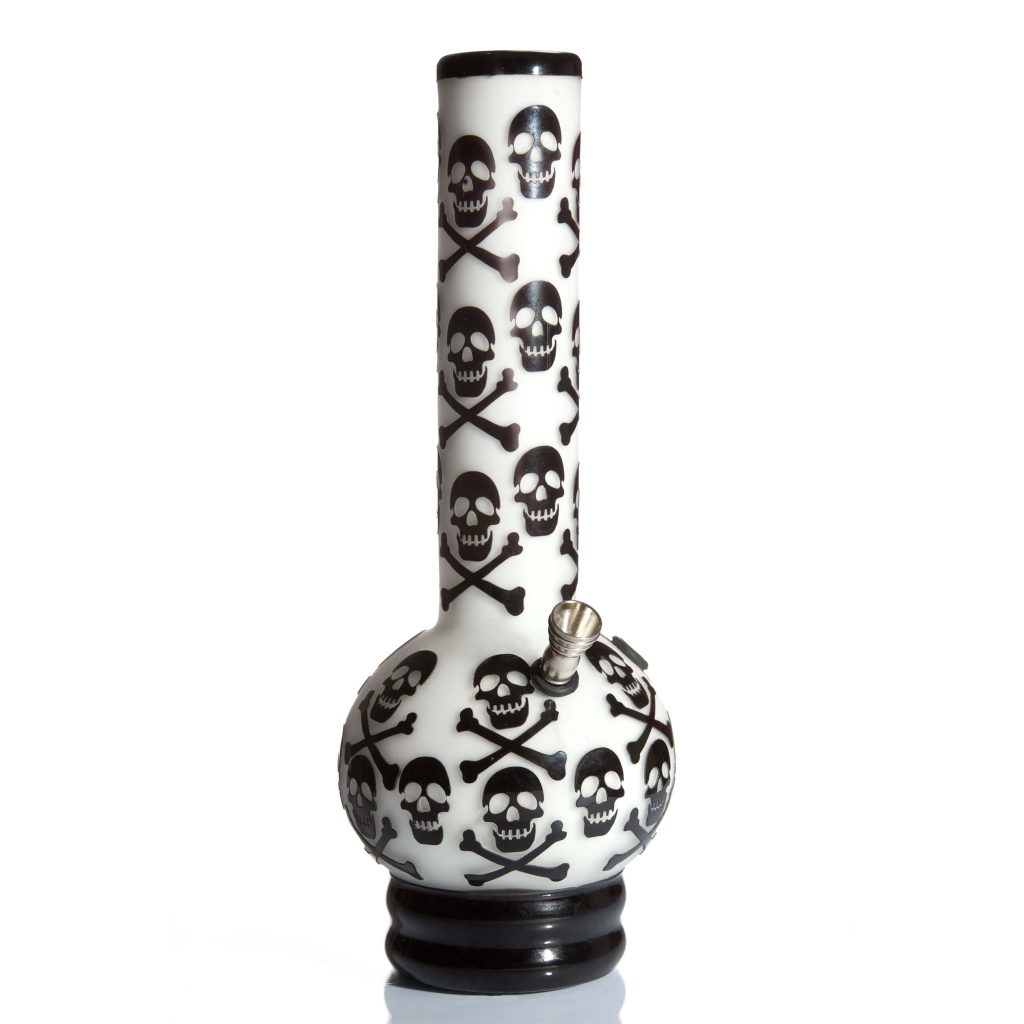
Ceramic absorbs and dissipates heat faster than glass, providing a smooth, flavoursome hit. As ceramic is widely available, they are much more affordable than glass. It’s a highly versatile material and can be customised into various shapes. Perfect if you are looking for a novelty display or a piece for those special occasions. Ideal for the creative smoker and artist among us!
Most ceramic bongs have glazed interiors to avoid resin build-up within the chamber. Many prefer to clean the bong manually rather than put it in the dishwasher to prevent damaging the glaze.
5. Silicone

A newcomer to the world of cannabis paraphernalia, silicone bongs are durable, lightweight, extremely portable and ideal for travelling. It’s an incredibly versatile and flexible material that can be moulded into any shape and size.
Like glass, the different parts of the silicone bongs can be removed, making them easier to clean. However, some preparation is required before, including a rinse with vinegar, as hot and soapy water won’t be enough to remove resin from the deepest crevices of the bong.
Inevitably, your glass bong won’t last forever, and silicone is an ideal alternative if you want a reasonably priced bong.
Male vs female bong?
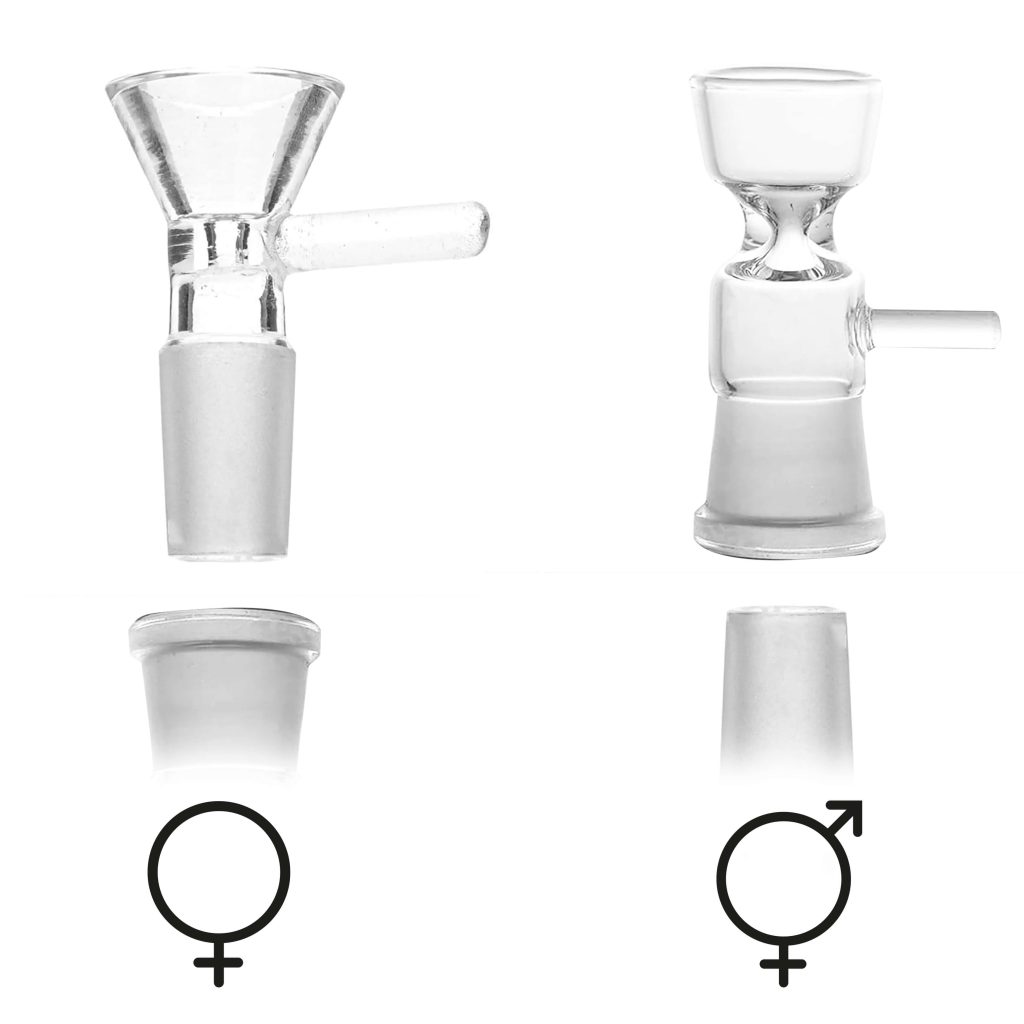
Before explaining the parts of the bong, we need to discuss how you determine if the bong you are using is male or female. Most dry-flower bongs will be female, which means the bowl will fit into the joint rather than be placed over the top. Male connections can be found on dab rigs designed for consuming concentrates.
Parts of a bong
Knowing what you’re looking at is vital if you want to make the most of your bong. Let’s dig into the eight main parts and their functions.
Mouthpiece
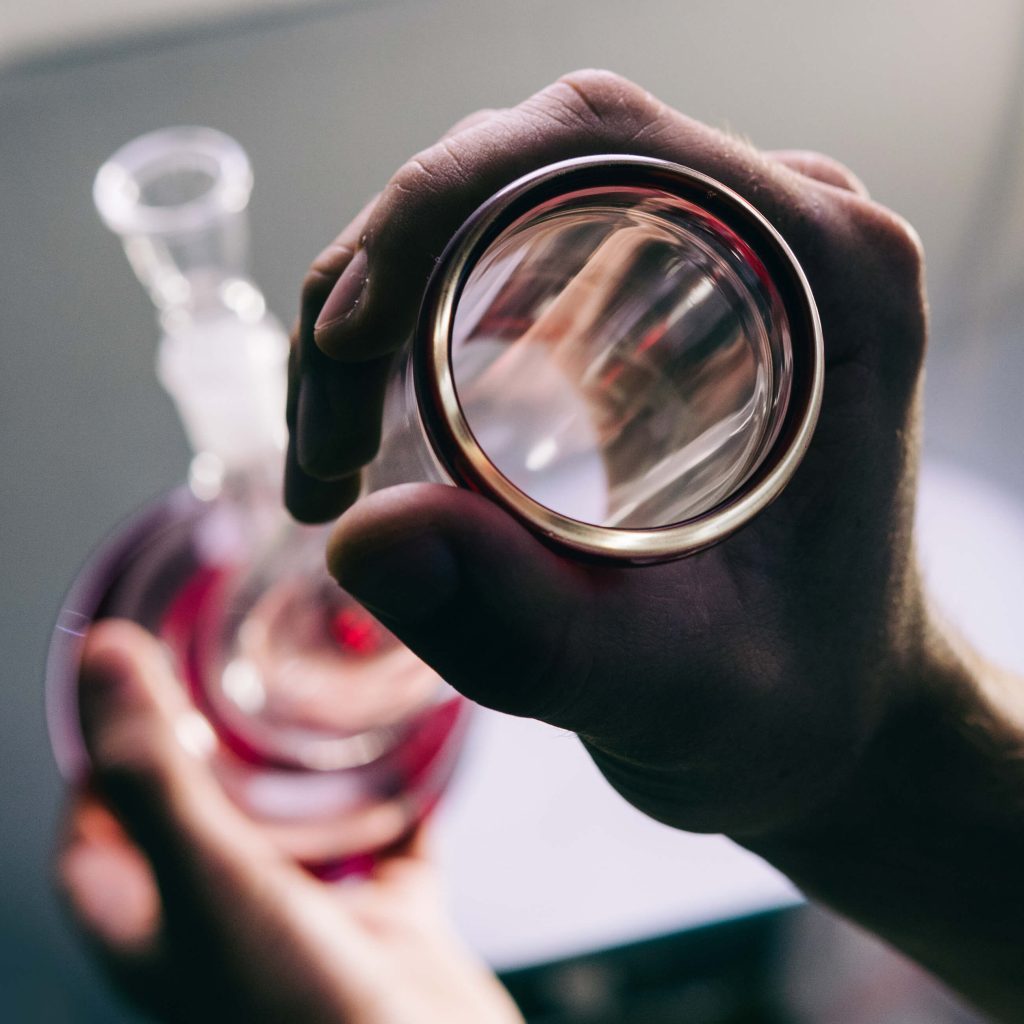
The mouthpiece is where you will put your mouth when inhaling. The lip is smooth and level, allowing you to create a tight seal around the mouthpiece for optimal usage. Traditionally, the mouthpiece was horizontal. Over time, the mouthpiece became vertical, which is more user-friendly. With the explosion of creativity in the glass-blowing subculture, the possibilities are endless, and you’ll come across a wide variety of mouthpieces.
Chamber

This is where the bellows of smoke are collected before being inhaled through the mouthpiece. The larger the chamber, the more you will inhale!
Base
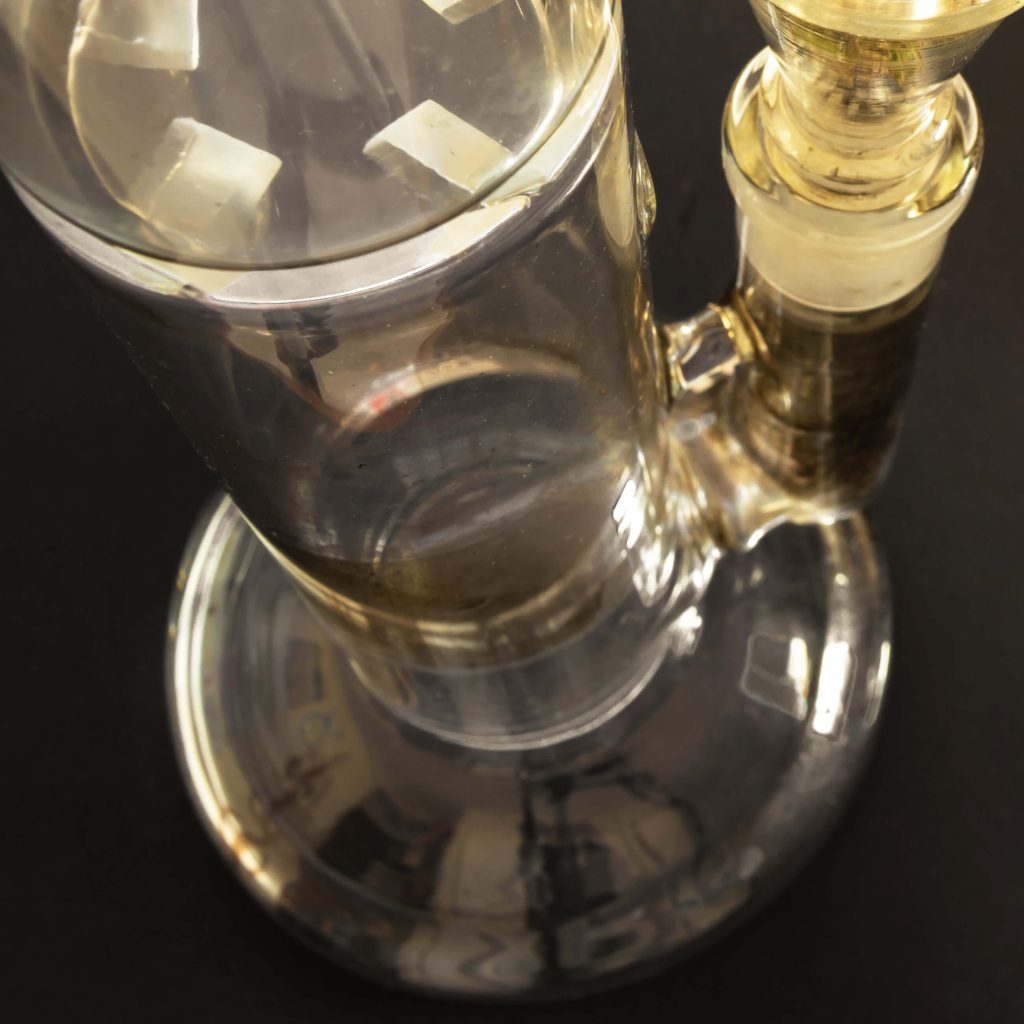
The bottom of the bong is called the base, where the water sits. The water acts as a diffuser for the combusted smoke before the chamber is filled with smoke. There are various styles, including beakers, straight tubes, and bowls.
Joint

The joint is where the downstem is placed and connects the chamber with the bowl. Some bongs with a fixed stem will not have a downstem, and the bowl will go directly into the joint. It is one of the bong’s most critical parts, as, without the joint, you cannot pull water from the bowl into the chamber.
Downstem
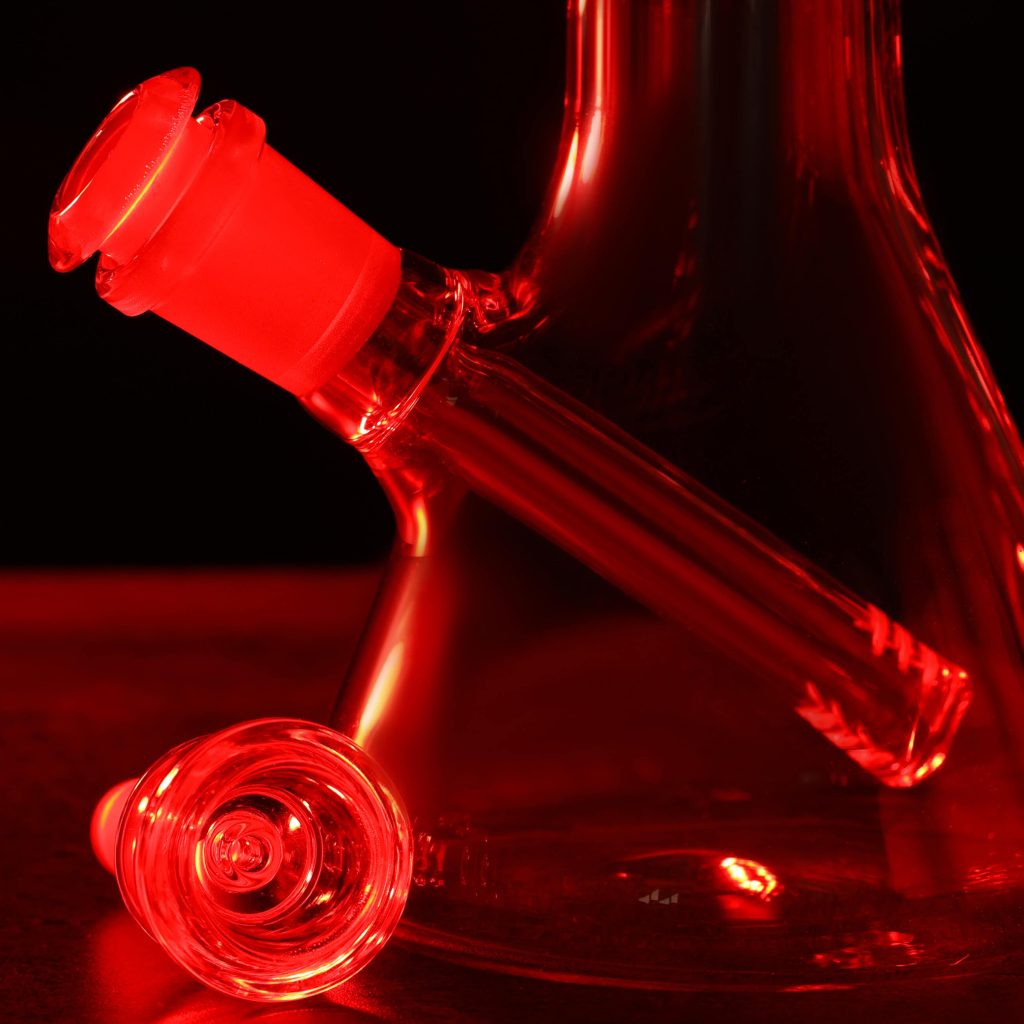
The hollow tube connecting the bowl and chamber is called the downstem. It provides the suction to pull smoke from the bowl, into the downstem and through the water. Most downstems have a female connection and can be found in three main sizes, 10, 14 and 18 mm.
Bowl

A bowl has space for dried herbs and a small carburetor, which goes directly into the downstem. It is vital to keep this clean, as it can dramatically affect the taste of your cannabis. The bowl should be removable with a female connection, which means it can fit directly into the joint. Bowls can come in various shapes and mediums, including glass, aluminium, and ceramic. Depending on the magnitude of the bong, they are mainly available in 10, 14, and 18 mm.
Percolator

Percolators come in many different forms, and similar to water, they help with additional filtration. While most are additional compartments in the main chamber, some can be added as attachments.
Percolators pull the smoke from the downstem through another water filtration, forcing it through tiny holes and breaking the smoke molecules into small bubbles, increasing its surface area. With a larger surface area, the temperature of the smoke will decrease, making the experience smoother.
Carburetor
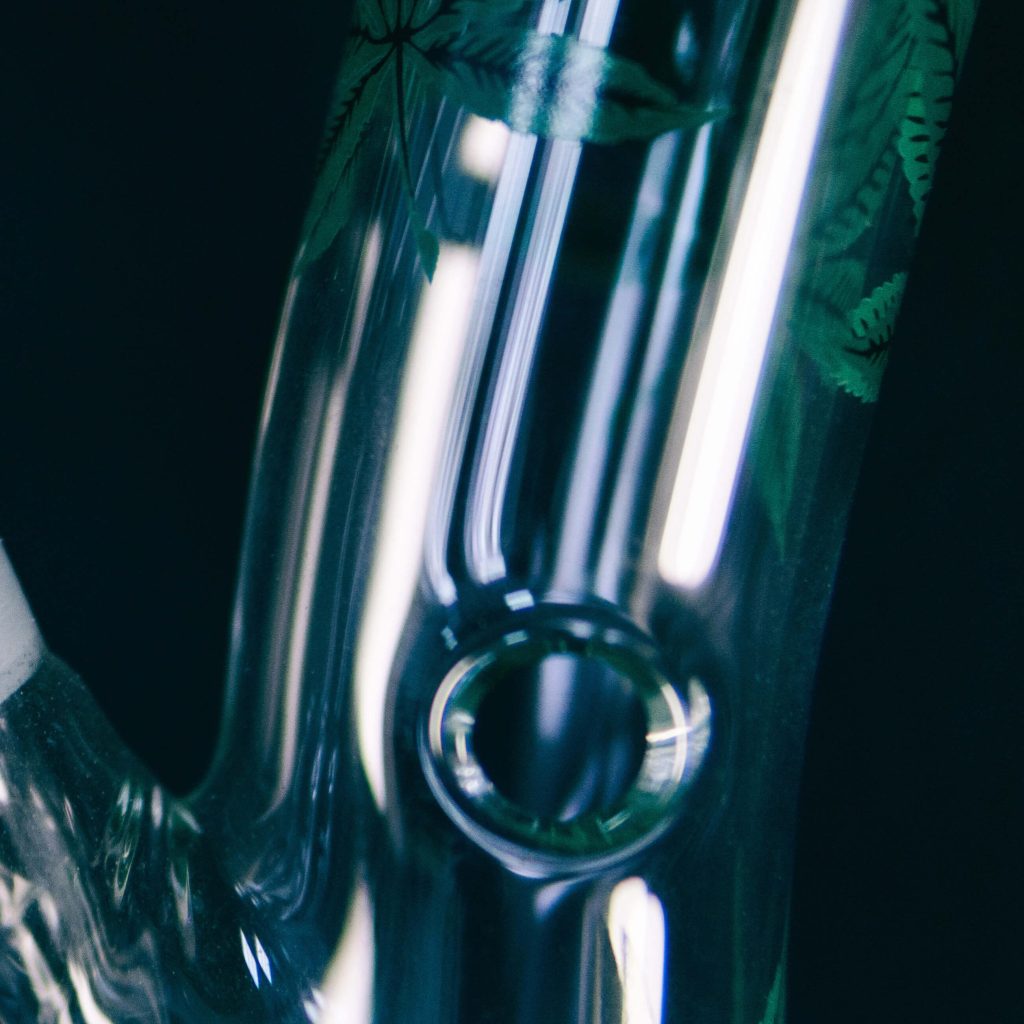
A carburetor, commonly known as the carb, is a small airflow hole in the bong’s base. It allows you to control airflow and should be covered when lighting the dried flower. Once the cherry has been ignited, you can control the burn by increasing or decreasing air through the carb. Once the chamber is filled, remove your finger; the air will rush into your lungs, like removing the downstem or bowl.
How to use a bong
Now that you are familiar with the parts of the bong, here is a step-by-step guide to using a bong!
1. Prepare the bong

Firstly, check that the bong is crystal clean and that you can access high-quality cannabis flowers. Fill the bong with the correct amount of water. Begin to pour the water through the mouthpiece, ensuring the downstem is submerged correctly.
It is recommended to try pulling air through the bong before adding dry flowers. Too much water and you will be getting bong water in your mouth during inhalation. Too little water and the smoke will be very harsh, causing you to cough.
2. Pack the bowl

Grind your cannabis with a grinder before packing the bowl, as this will create optimal burnability and ensure your flowers do not block the bowl. Depending on your requirements, you can put as much cannabis in the bowl as desired. A pipe screen is also optional if you do not want any cannabis being pulled through the downstem and into the water.
Grab a small amount of ground cannabis, place it into the bowl, and tap it down. Don’t pack the cannabis too tight, as it will cause a lack of airflow and decreased burnability!
3. Light the bowl

Using a hemp wick, light the bowl centrally while continuing to breathe in on the mouthpiece. Inhaling from the mouthpiece will pull the combusted smoke into the downstem and through the water before filling the chamber. Be warned, the harder you inhale, the greater volume of smoke inside the chamber.
4. Inhale and clear the chamber
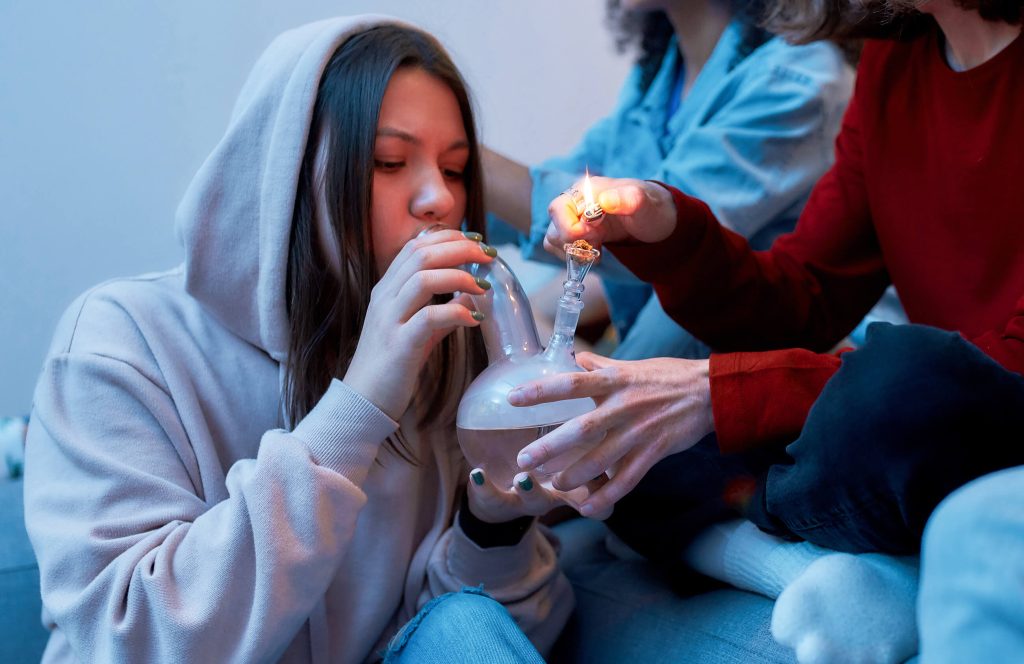
First, ensure you have filled the chamber with the required volume of smoke. Then remove the bowl, or if the bowl and downstem are attached, remove the downstem or your finger from the carb. This allows optimal airflow, pushing the smoke through the downstem, filling the chamber and directly into your lungs. Inhale and exhale.
How to clean a bong
It is always recommended to clean your bong after every session to avoid the building up of unwanted resin, which can hinder your smoking experience. Many bong cleaning products are on the market, but 99% isopropyl alcohol and coarse salt are usually the go-to method.

- Take apart the components of the bong and place the downstem and bowl into a zipper-locked bag filled with an isopropyl alcohol solution with warm water.
- The larger chamber can be filled with the same solution, cover the mouthpiece and shake. Then leave for 10 to 15 minutes.
- Empty the remaining water from the larger chamber, and remove the minor components from the ziplocked bag. Rinse twice with soap and water, and leave to dry.
- Carefully put the bong back together, refill, and enjoy!
Practice makes perfect

Like with everything, practice makes perfect. Now that you have learned about the bong parts and how to use one, you can understand how to maximise each session. Before you know it, you’ll be packing bowls for all your friends!
Many cannabis connoisseurs recommend using a glass bong to thoroughly enhance your smoking experience, as it provides both a clean and flavoursome hit. With an ever-growing glass-blowing community, there is a wide variety of unique pieces, and there is definitely a bong out there for you!
Do you have a favourite bong, or do you have some great tips on keeping your bong clean? Please let us know in the comments below.
-
Disclaimer:
Laws and regulations regarding cannabis use differ from country to country. Sensi Seeds therefore strongly advises you to check your local laws and regulations. Do not act in conflict with the law.
You may like
Cannabis
White House Finally Comments On Marijuana Industry
Published
9 hours agoon
April 1, 2025By
admin
Part of the cannabis industry supported the new president, betting he was going to move and move quickly on cannabis – the White House finally commented.
The cannabis industry has been a boon for consumers, medical patients, veterans and legal states, but for the thousands of mom and pop businesses is has been a roller coaster. With a huge demand, it would seem to be easy money, but the federal, tax, and banking restrictions have made it difficult to grow and expand. Part of the industry were all for the new administration assuming they would support positive change, but many in the new cabinet and the House Speaker Mike Johnson are foes. Now the White House finally comments on marijuana industry…and it doesn’t show a clear path.
RELATED: Music Is A Turn On Like Sex And Marijuana
The administration’s current stance on marijuana reform is marked by inaction, despite campaign promises and earlier signals of support for cannabis-related reforms. A White House official recently confirmed that “no action is being considered at this time” regarding marijuana policy, leaving advocates and industry stakeholders uncertain about the administration’s priorities.

During his campaign, the resident expressed support for rescheduling marijuana under the Controlled Substances Act (CSA), which would move it from Schedule I to Schedule III, easing restrictions on medical use and enabling cannabis businesses to access banking and tax benefits. However, since taking office, no concrete steps have been taken to advance this initiative. A DEA hearing on rescheduling, initially planned for January 2025, was postponed due to procedural appeals and remains unscheduled.
The president has also voiced support for state autonomy in cannabis policy and endorsed state-level legalization initiatives, such as Florida’s failed 2024 ballot measure for recreational marijuana. While this reflects a more favorable stance compared to his first term, his administration has yet to prioritize federal reforms like the SAFE Banking Act, which would facilitate banking services for cannabis businesses. Efforts to include such measures in a government funding bill late last year were unsuccessful.
The delay in federal action has significant implications for the cannabis industry. Rescheduling marijuana could alleviate financial burdens by eliminating restrictions under IRS Code Section 280E and promoting medical research. However, the stalled process leaves businesses navigating regulatory uncertainties and limited financial access.
RELATED: The Science Behind Why Music Sounds So Much Better When You’re High
While stakeholders continue lobbying for reform, the administration appears focused on other priorities such as immigration and foreign policy. Advocates hope the President will leverage his influence to advance cannabis reform, but for now, the issue remains sidelined. Until then the industry struggles and waits.
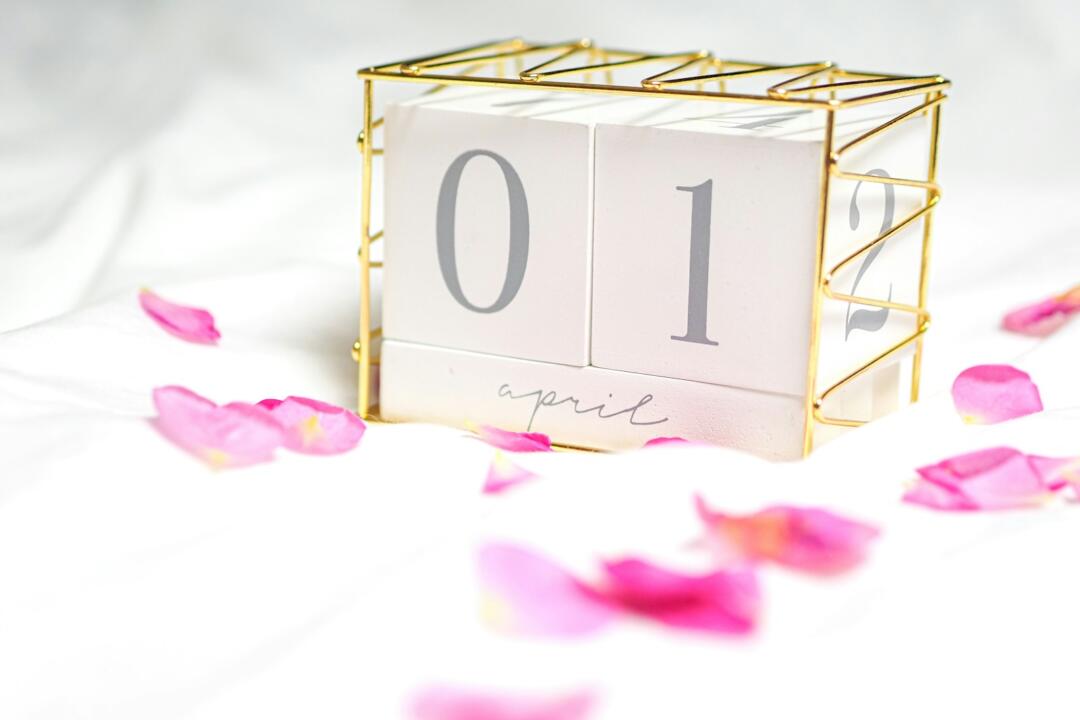
Love it or hate it – April Fool’s Day is here to stay…and here is the history behind this unique tradition
From Britain to India, it is a popular day of pranks, laughs and silliness. From Google to Burger King has participated and some people spend endless hours planning the perfect joke. But what is the history behind April Fool’s Day? It is celebrated annually on April 1, is a global tradition marked by pranks and jokes. Despite its widespread popularity, the origins of this playful holiday remain uncertain, with several theories tracing its roots to different historical events and cultural practices.
RELATED: Why Do Whales Keep Swallowing People
Both April Fools’ Day and Día de Los Inocentes mark days when people play practical jokes on one another. April Fools’ Day is primarily celebrated in English-speaking countries, while Día de Los Inocentes is more widely marked in Spanish-speaking countries. A key way Día de Los Inocentes differs from April Fools’ Day is it celebrated on December 28th every year
Some of the most famous April Fool’s pranks include The Swiss Spaghetti Harvest, where the BBC broadcast a segment showing peasants harvesting spaghetti from trees in Switzerland. Another notable prank was when radio station KGB-FM in San Diego announced that the Space Shuttle was landing at a local airport, drawing over 1,000 people. Google has also been known for its annual April Fool’s jokes, such as the “Hyper Text Coffee Pot Control Protocol”. Additionally, brands like Pornhub have participated with humorous site name changes, such as “Cornhub” and “Hornhub”
One popular theory links April Fool’s Day to the adoption of the Gregorian calendar in 1582, initiated by Pope Gregory XIII. Before this change, many European countries followed the Julian calendar, where the new year began around late March or early April. Those who continued celebrating the old New Year date were mocked as “April fools,” giving rise to the holiday’s name and customs.

Another theory suggests that April Fool’s Day may have originated from ancient spring festivals such as Rome’s Hilaria or India’s Holi. Hilaria, celebrated in late March, involved games, disguises, and mockery of neighbors, while Holi featured playful pranks and joyous festivities marking the arrival of spring.
The first definitive reference to April Fool’s Day comes from a 1561 Flemish poem by Eduard de Dene. In this humorous tale, a nobleman sends his servant on absurd errands for nonexistent items, a prank still known as a “fool’s errand.” This poem solidifies April Fool’s Day as an established tradition by the late Middle Ages.
In France, the day became known as poisson d’avril (“April fish”), where children would pin paper fish on unsuspecting friends’ backs. This tradition symbolizes gullibility, likening victims to young fish easily caught.
RELATED: Fun Life Lessons Learned From Spaghetti Westerns
By the 18th century, April Fool’s Day had spread across Europe and North America. In Scotland, it evolved into “Gowkie Day,” where people were sent on wild goose chases. The following day, “Tailie Day,” involved pranks like pinning “kick me” signs on others. Media outlets also began participating in the holiday by publishing fake headlines and stories—a tradition that continues today.
While the exact origin remains debated, April Fool’s Day thrives as an opportunity for lighthearted fun worldwide. Its enduring appeal lies in its ability to bring laughter and mischief into everyday life, transcending cultural boundaries and historical uncertainties.

When sick or sad, people gravitate to comfort food – but does it make a difference?
Everyone gets down, stressed or just in a mood, and a number of people wants something to make them feel good. Comfort food is a go to indulgence which lifts the spirts. In North America, some top comfort foods include pot roast, lasagna, chocolate, ice cream and cookies….around the world it includes rice, yogurt, pizza, ramen, and boeuf bourguignon. It is an excuse to enjoy favorite flavors, but does comfort food actually help?
RELATED: Tips To Develop A Better Morning Routine
The answer is nuanced, as comfort foods can provide both emotional relief and potential drawbacks depending on the individual and circumstances. Comfort food has been shown to improve mood temporarily, especially for emotional eaters. Studies suggest that the palatability of food plays a significant role in mood enhancement, with tastier foods providing greater comfort during moments of sadness or stress. Emotional eaters often experience satisfaction and mood improvement after consuming comfort food, while non-emotional eaters may not derive the same benefit, particularly under stress. Additionally, comfort foods can evoke nostalgia and positive memories, acting as social surrogates that remind individuals of meaningful connections and moments of belonging.

From a physiological perspective, consuming sweet and fatty comfort foods can release dopamine and serotonin, chemicals linked to pleasure and mood elevation. This process can dampen stress responses in the body by reducing cortisol levels and activating the hypothalamic-pituitary-adrenal (HPA) axis. However, these effects are often short-lived and may lead to unhealthy eating habits if relied upon excessively.
While comfort foods can provide immediate emotional relief, they may also contribute to negative health outcomes if consumed excessively. High-calorie comfort foods rich in sugar and fat are associated with weight gain, metabolic risks, and increased likelihood of depression over time. This creates a feedback loop where individuals turn to unhealthy food to combat stress but experience worsening mental health as a result.
RELATED: The Science Behind Why Music Sounds So Much Better When You’re High
Interestingly, studies show that healthy alternatives like fruits and vegetables can offer similar mood-boosting benefits without the health risks associated with traditional comfort foods. Incorporating omega-3 fatty acids or dark chocolate in moderation can also enhance mood while supporting overall health. Social aspects of eating—such as sharing meals with loved ones—can amplify the emotional benefits of food without overindulgence.

White House Finally Comments On Marijuana Industry

Stop Using Bat Poop to Fertilize Your Weed Plants Immediately, Here is Why…

The History Behind April Fool’s Day

Star signs and cannabis strains: April 2025 horoscopes

Does Comfort Food Actually Help

Connect to cannabis history with three legacy strains from Paradise Seeds

This State’s Cannabis Revenue Keeps Pouring In

Major Bloom: Cultivating community, creativity, and cannabis in Worcester

How a Colorado operator stumbled onto ‘blueprint for laundering marijuana’

Northern Ireland: Man charged after £425,000 worth of cannabis seized

Distressed Cannabis Business Takeaways – Canna Law Blog™

United States: Alex Malyshev And Melinda Fellner Discuss The Intersection Of Tax And Cannabis In New Video Series – Part VI: Licensing (Video)

What you Need to Know

Drug Testing for Marijuana – The Joint Blog

NCIA Write About Their Equity Scholarship Program

It has been a wild news week – here’s how CBD and weed can help you relax

Cannabis, alcohol firm SNDL loses CA$372.4 million in 2022

A new April 20 cannabis contest includes a $40,000 purse

Your Go-To Source for Cannabis Logos and Designs

UArizona launches online cannabis compliance online course
Trending
-

 Cannabis News2 years ago
Cannabis News2 years agoDistressed Cannabis Business Takeaways – Canna Law Blog™
-

 One-Hit Wonders2 years ago
One-Hit Wonders2 years agoUnited States: Alex Malyshev And Melinda Fellner Discuss The Intersection Of Tax And Cannabis In New Video Series – Part VI: Licensing (Video)
-

 Cannabis 1012 years ago
Cannabis 1012 years agoWhat you Need to Know
-

 drug testing1 year ago
drug testing1 year agoDrug Testing for Marijuana – The Joint Blog
-

 Education2 years ago
Education2 years agoNCIA Write About Their Equity Scholarship Program
-

 Cannabis2 years ago
Cannabis2 years agoIt has been a wild news week – here’s how CBD and weed can help you relax
-

 Marijuana Business Daily2 years ago
Marijuana Business Daily2 years agoCannabis, alcohol firm SNDL loses CA$372.4 million in 2022
-

 California2 years ago
California2 years agoA new April 20 cannabis contest includes a $40,000 purse



